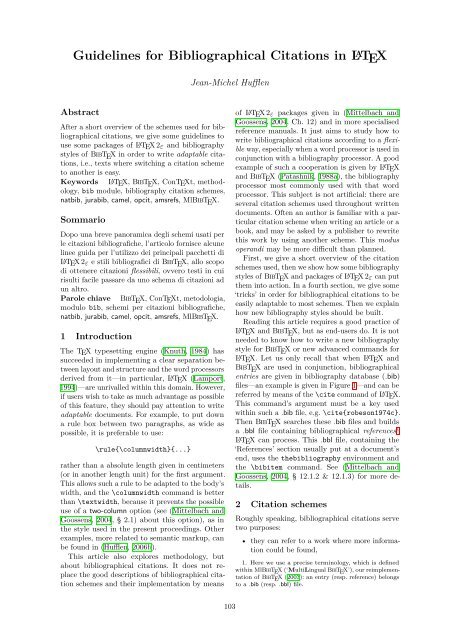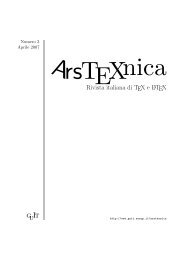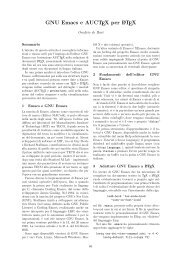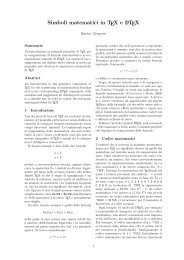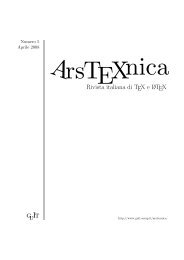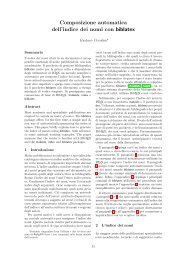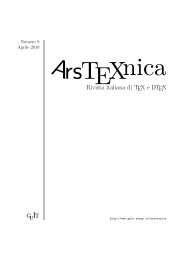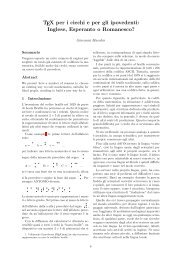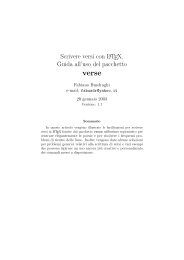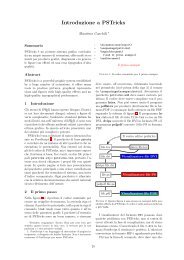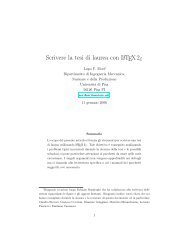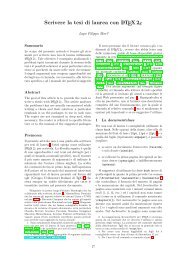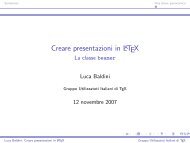ArsTeXnica, Numero 4, Ottobre 2007 - GuIT - Scuola Superiore Sant ...
ArsTeXnica, Numero 4, Ottobre 2007 - GuIT - Scuola Superiore Sant ...
ArsTeXnica, Numero 4, Ottobre 2007 - GuIT - Scuola Superiore Sant ...
You also want an ePaper? Increase the reach of your titles
YUMPU automatically turns print PDFs into web optimized ePapers that Google loves.
Guidelines for Bibliographical Citations in L ATEX<br />
Abstract<br />
After a short overview of the schemes used for bibliographical<br />
citations, we give some guidelines to<br />
use some packages of L ATEX 2ε and bibliography<br />
styles of BibT E X in order to write adaptable citations,<br />
i.e., texts where switching a citation scheme<br />
to another is easy.<br />
Keywords L ATEX, BibT E X, ConTEXt, methodology,<br />
bib module, bibliography citation schemes,<br />
natbib, jurabib, camel, opcit, amsrefs, MlBibT E X.<br />
Sommario<br />
Dopo una breve panoramica degli schemi usati per<br />
le citazioni bibliografiche, l’articolo fornisce alcune<br />
linee guida per l’utilizzo dei principali pacchetti di<br />
L ATEX 2ε e stili bibliografici di BibT E X, allo scopo<br />
di ottenere citazioni flessibili, ovvero testi in cui<br />
risulti facile passare da uno schema di citazioni ad<br />
un altro.<br />
Parole chiave BibT E X, ConTEXt, metodologia,<br />
modulo bib, schemi per citazioni bibliografiche,<br />
natbib, jurabib, camel, opcit, amsrefs, MlBibT E X.<br />
1 Introduction<br />
The TEX typesetting engine (Knuth, 1984) has<br />
succeeded in implementing a clear separation between<br />
layout and structure and the word processors<br />
derived from it—in particular, L ATEX (Lamport,<br />
1994)—are unrivalled within this domain. However,<br />
if users wish to take as much advantage as possible<br />
of this feature, they should pay attention to write<br />
adaptable documents. For example, to put down<br />
a rule box between two paragraphs, as wide as<br />
possible, it is preferable to use:<br />
\rule{\columnwidth}{...}<br />
rather than a absolute length given in centimeters<br />
(or in another length unit) for the first argument.<br />
This allows such a rule to be adapted to the body’s<br />
width, and the \columnwidth command is better<br />
than \textwidth, because it prevents the possible<br />
use of a two-column option (see (Mittelbach and<br />
Goossens, 2004, § 2.1) about this option), as in<br />
the style used in the present proceedings. Other<br />
examples, more related to semantic markup, can<br />
be found in (Hufflen, 2006b).<br />
This article also explores methodology, but<br />
about bibliographical citations. It does not replace<br />
the good descriptions of bibliographical citation<br />
schemes and their implementation by means<br />
Jean-Michel Hufflen<br />
103<br />
of L ATEX 2ε packages given in (Mittelbach and<br />
Goossens, 2004, Ch. 12) and in more specialised<br />
reference manuals. It just aims to study how to<br />
write bibliographical citations according to a flexible<br />
way, especially when a word processor is used in<br />
conjunction with a bibliography processor. A good<br />
example of such a cooperation is given by L ATEX<br />
and BibT E X (Patashnik, 1988a), the bibliography<br />
processor most commonly used with that word<br />
processor. This subject is not artificial: there are<br />
several citation schemes used throughout written<br />
documents. Often an author is familiar with a particular<br />
citation scheme when writing an article or a<br />
book, and may be asked by a publisher to rewrite<br />
this work by using another scheme. This modus<br />
operandi may be more difficult than planned.<br />
First, we give a short overview of the citation<br />
schemes used, then we show how some bibliography<br />
styles of BibT E X and packages of L ATEX 2ε can put<br />
them into action. In a fourth section, we give some<br />
‘tricks’ in order for bibliographical citations to be<br />
easily adaptable to most schemes. Then we explain<br />
how new bibliography styles should be built.<br />
Reading this article requires a good practice of<br />
L ATEX and BibT E X, but as end-users do. It is not<br />
needed to know how to write a new bibliography<br />
style for BibT E X or new advanced commands for<br />
L ATEX. Let us only recall that when L ATEX and<br />
BibT E X are used in conjunction, bibliographical<br />
entries are given in bibliography database (.bib)<br />
files—an example is given in Figure 1—and can be<br />
referred by means of the \cite command of L ATEX.<br />
This command’s argument must be a key used<br />
within such a .bib file, e.g. \cite{robeson1974c}.<br />
Then BibT E X searches these .bib files and builds<br />
a .bbl file containing bibliographical references 1<br />
L ATEX can process. This .bbl file, containing the<br />
‘References’ section usually put at a document’s<br />
end, uses the thebibliography environment and<br />
the \bibitem command. See (Mittelbach and<br />
Goossens, 2004, § 12.1.2 & 12.1.3) for more details.<br />
2 Citation schemes<br />
Roughly speaking, bibliographical citations serve<br />
two purposes:<br />
• they can refer to a work where more information<br />
could be found,<br />
1. Here we use a precise terminology, which is defined<br />
within MlBibT E X (‘MultiLingual BibT E X’), our reimplementation<br />
of BibT E X (2003): an entry (resp. reference) belongs<br />
to a .bib (resp. .bbl) file.


